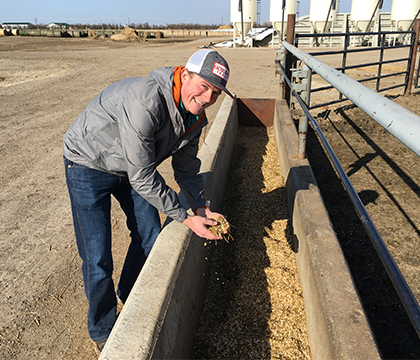
Researchers studying barley processing options in feed trial at the LFCE
Steamed or soaked? Mid-flake or coarse-flake? These are the questions that University of Saskatchewan researchers are exploring as they determine how best to process barley for cattle feed.
By Lana HaightBarley is the most common grain used for finishing cattle in Western Canada. It’s typically dry rolled, but as a growing number of producers consider feeding steam-flaked corn, some wonder if the same process can work for barley.
For cattle to properly digest the starch in corn, the corn is processed through a steam conditioner before being rolled in a feed mill. But there’s a price to pay for this option: a steam flaking unit can cost between $78,000 and $300,000.
“If they are going to put the money into a steam flaking unit, they want to know if it will add value to their barley in the same way that it increases the value of corn,” says graduate student Coleman Nixdorff. His supervisor is Dr. Greg Penner (PhD), associate professor and the USask Centennial Enhancement Chair in Nutritional Physiology in the College of Agriculture and Bioresources.
Nixdorff, who is now in the second year of his Master of Science degree program, can relate to producers’ concerns. His family owns Yankee Valley Ranch, located east of Airdrie, Alta., where they raise purebred Herefords and operate a commercial cow-calf operation.
Nixdorff’s feed project started at the Livestock and Forage Centre of Excellence in mid-March with 420 steers— each weighing about 362 kg (800 lb.). The research team divided the herd into four, with each group of 105 cattle (split into 7 pens each) receiving the following feed options:
- Group 1: dry-rolled barley (control group)
- Group 2: tempered barley that’s been soaked in water for 24 hours and then rolled (common at feedlots during the summer)
- Group 3: mid-flake steam-flaked barley (barley that’s been steamed and then rolled)
- Group 4: coarse-flake steam-flaked barley (the same process as mid-flake, but the flake isn’t as flat).
The study’s dry-rolled and tempered barley were processed at the LFCE, while the USask-owned Canadian Feed Research Centre in North Battleford, Sask., produced the project’s steam-flaked barley.
“When the barley comes out of the steam chest, it’s flaked by rolling through a roller mill. This gelatinizes the starch, making it more available, and increases the surface area of the grain. It also decreases the fine particles in the feed because of the moisture that’s been added,” says Nixdorff.
It is not clear if steam-flaking increases or lowers the risk of rumen acidosis, a digestive disorder in cattle that occurs when acid is produced faster than it can be used in the digestive process.
Nixdorff expects the animals receiving steam-flaked barley to gain weight faster, using the nutrients more efficiently. Starch utilization contributes to weight gain. As the feed’s surface area increases and gelatinization increases, more starch is available for the rumen microbes to digest. That’s why the flatter, mid-flake barley with more surface area will have more digestible energy than the coarse-flake feed, suggests Nixdorff.
“But the increase in the amount of energy from the processed barley could change the way the steers deposit fat and possibly change the yield grade. They might start depositing fat faster and that could affect the way they grade out on the rail.”

Coleman Nixdorff checks out a feed bunk at the LFCE.
During the study, Nixdorff is calculating how much feed the animals consume, the amount of weight they gain and the gain-to-feed ratio (feed efficiency). He’s also measuring their fecal starch concentrations, which will indicate if the grain has been fully digested.
The study will continue for another 12 more weeks until the steers have reached the target live weight of 650 kg (1,433 lb.). After slaughter, Nixdorff will record the animals’ carcass weights, yield grades and quality grades. Their livers will also be examined for abscesses, a sign of rumen acidosis caused by feed that’s too high in carbohydrates.
Based on the study’s results, Nixdorff hopes to make a recommendation on the economic viability of purchasing a steam flaker for barley processing. He says for the beef industry to continue growing, producers need to be looking for ways to improve.
“If we were still feeding cattle the way we were 30 years ago, we wouldn’t see the production efficiency we see today,” says Nixdorff, who plans to eventually return to his family’s ranch in Alberta and work as a feedlot/cow-calf nutritionist.
“There’s always room for improvement and change.”
The research was funded by SaskBarley Development Commission and the Saskatchewan Cattlemen's Association.
